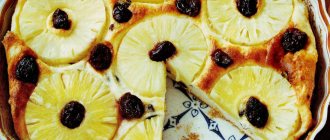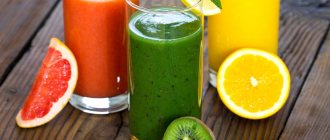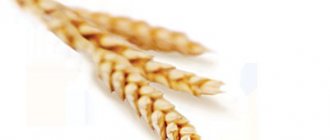For whom was the Fitness Desserts program created?
The Fitness Desserts course program is designed for people leading an active lifestyle and involved in fitness. Only understanding the basic principles of a healthy and balanced diet will help you create healthy breakfasts, snacks and holiday desserts without worrying about “unburned” extra calories.
What calorie content do desserts from the “Fitness Desserts” course have?
Most of the desserts from our course have a moderate calorie content (up to 200 kcal), but some of them have a higher calorie content:
- Topic 1: Panna cotta - 83 kcal, Chia pudding - 169 kcal, Berry granola - 148 kcal;
- Topic 2: Oatmeal muffin with pear and hazelnuts - 329 kcal, Blueberry and star anise muffin - 233 kcal, Lemon muffin with chia seeds - 167 kcal, Chocolate cupcake - 234 kcal;
- Topic 3: Matcha Cheesecake - 170 kcal, Mango Cheesecake - 206 kcal;
- Topic 4: Honey cake - 222 kcal, Crepeville - 149 kcal;
- Topic 5: “Tirol” cake – 215 kcal;
- Topic 6: Trondheim cake - 168 kcal.
Why are there no low-calorie desserts based on low-fat products in the program?
Because calories are different. Many people believe that if you expend more calories than you consume, you will lose weight; if you consume less, you will gain weight. It's a delusion. Each type of nutrient (protein, fat or carbohydrate) triggers a chain of hormonal reactions, each of which leads to a specific result. Many scientific articles prove that for the same amount of calories, it is the composition of the diet that can significantly affect weight loss and the ratio of muscle mass to body fat.
Focusing on counting calories rather than the quality of your diet only hurts your weight loss process and doesn't hold up in the long run. This approach inherently discriminates against all fat-containing foods, even though many contain health benefits, promote satiety, and have many other benefits relative to low-fat foods.
Focusing on calories rather than food perpetuates the myth that the obesity epidemic is a consequence of overeating and a sedentary lifestyle, and can make it seem like eating a few calories means you can continue to lie on the couch and eat chips. What difference does it make what you eat if it is less than or equal to your daily energy requirement? People who count calories often tend to neglect nutritious foods. The emphasis is on “diet” foods, which are low in calories but also lack nutritional value. Foods such as low-fat dairy products and diet sodas fill up the diet and do not provide the body with the energy it needs to maintain functionality and a healthy metabolism.
Today, most nutritionists in the world still insist on counting calories, and many still recommend low-fat foods, sweeteners and diet drinks. However, it would be more logical to replace all these products with natural ones, add vegetables and fruits, eat full-fledged dairy products, but in moderation, drink more water and try to diversify your diet as much as possible.
Sport can also turn into a trap for a person counting calories - it becomes an indulgence and gives the idea that food can be worked off. This approach makes any intentional physical activity a punishment and turns sport into something that a person is forced to do to compensate for what he has eaten or to build up a supply for the coming days.
Not all calories have the same effect on our bodies, and not all calories listed on food labels are utilized by the body or even available to the body. For example, fiber, which is found in large quantities in whole grain flour and nuts, is always taken into account in the calorie content of the product, but it is practically not absorbed.
It is very important to correctly calculate the daily intake and adapt it to your lifestyle; in this case, by eating one such dessert, you provide yourself with a large amount of healthy nutrients, saturate your body and ultimately want to eat less.
The basis of a balanced diet, especially if you lead an active lifestyle (and this should also be available information to your customers if you prepare such desserts for sale) is the presence of all macronutrients in a certain proportion in the dish/diet and it is desirable that their source was foods with high nutritional value: simply put, natural products, all those that we use in the course program. Only then will the dessert not cause harm to the body, it will be absorbed more slowly, some of the energy will be spent on digestion, and such a dessert will ultimately become a healthy, wholesome and high-quality alternative to even the most low-calorie dessert with sweeteners. This is the fitness concept.
To summarize all of the above, people who maintain an active lifestyle should keep in mind the composition and calorie content of their entire diet. The catch is that often there is not enough information on this subject and it is impossible to adequately distinguish between “healthy” and “harmful” desserts. But if we convey all of the above to you and your consumer, then perhaps the opinion regarding “fitness” nutrition will change, and as a result, a concept will be formed where fitness = pp = healthy lifestyle.
Why are there no low-calorie desserts with sweeteners in the program?
Most published studies have endorsed the safety of these supplements, but there is a lack of truly conclusive research to freely recommend sweeteners for everyday use.
It is a huge misconception to believe that sweeteners have advantages over sugars with a low glycemic index, due to a reduction in caloric intake and, as a result, weight loss.
Sweeteners are marketed as a calorie-free alternative to table sugar and, in theory, should promote weight loss. However, this will only happen if there is no compensatory sugar consumption. Based on modern research on sweeteners, the appetite stimulation effect of their use is of some concern. If you choose a sweetener at the moment of need for sweets, a discrepancy occurs, a repeated feeling of hunger arises, and it seems to you that the body’s request for “sweets” has been satisfied. Because when the natural tandem of sweetness and calorie content is missing, the body's natural food regulation processes are disrupted, and this can cause changes that hinder, rather than promote, weight loss.
It turns out that the general belief that sweeteners can promote weight loss by reducing calories is wrong. In addition, several studies have documented associations between long-term consumption of sweeteners and weight gain.
Working with the body is multifactorial, and there is not enough evidence that using sweeteners for weight management is truly effective. If these general lifestyle principles are followed, artificial sweeteners, like the sugars they replace, will play a minor role in our diet and our lives.
Why are there no extreme sports desserts with protein in the program?
Such desserts can be recommended for professional athletes, but their need for protein is so high that desserts with protein will not be able to fill the daily nutrient requirement.
Recommendations for professional athletes are generally the same as for people leading an active lifestyle. The only difference is the increased energy requirement. But the ratio of food is the same; simply, roughly speaking, you need to eat more in volume. Protein can only be used as a supplement to a healthy, nutritious diet. And professional athletes know this. Consuming an additional source of protein in the form of sports supplements means that at least the same amount of protein must be consumed with a nutritious meal throughout the day. The need for sports nutrition usually arises in people whose goal is to gain muscle mass. Athletes using sports nutrition train with additional weights to promote muscle growth. You can always replace meals with a mixture, but the question is whether it is necessary. Typically, these shakes and bars are quickly digestible. On the one hand, this does not strain the digestive system, but on the other, it can provoke a premature feeling of hunger and reduce the energy that a person spends on digestion, just consuming nuts and whole grains. That's why we limited the use of protein in the course, to show that you can get much more benefits from regular foods by including them in your diet.
What are fitness desserts and why strict diets don't work
In 2021, we're really trying to choose health. But we don’t want to give up our taste habits either. And it’s not necessary, agrees functional nutrition specialist Yulia Zelikova. She acted as an expert in developing recipes. Having caught Yulia at the presentation of new fitness desserts, we asked her about her innate love for sweets and the modern approach to proper nutrition.
How to eat after six and not be afraid of extra pounds
Blitz interview with nutritionist Yulia Zelikova
GastroSev choice #1 – apple-banana cake with crumble made from oat bran, honey, apple and dried fruits; 232 kcal/100 g. Photo: Gastronomic Sevastopol.
Why are we even drawn to sweets?
This is a natural need. A way to relieve stress and take a break. We often go for a cake when we are stuck in a cocoon of important things and want to take a break. Take a break, feed your brain with glucose so that it makes an important decision.
And then we will feel guilty and want to eat it again. In this sense, dietary desserts are a good alternative to traditional ones. Do you know that because of the feeling of guilt after eating too much chocolate, we produce glucocorticoid hormones, which cause the body to store fat even more? It's better to eat a healthy option and not be upset.
When is the best time to eat it? How does dietetics now relate to diet?
You need to pay attention to what time you feel most hungry. There are people who work at night, there are young mothers who finally put everyone to bed at 12, and only then can they sit down and breathe out. This is fine. If a person maintains his daily calorie intake, he will still lose weight.
If you are comfortable eating in the evening, shift most of your daily calories to the evening. Just look at how much you have already eaten and how much you can normally eat. If you want both dinner and sweets, cut your lunch short. The main thing is the general daily norm. This math always works.
So you can forget about the “don’t eat after 6” rule?
There is no single correct nutrition timing. But a routine is still necessary, because otherwise most people relax. Even if we count calories, we will still forget something somewhere or misestimate it. For example, two large apples have the same caloric value as one large Snickers. Rarely does anyone think about this. But if we are afraid of Snickers, then we will not be afraid of the apple.
How much fruit can you lose weight in general? Fit desserts have them.
The main thing, again, is to look at the label. If this particular cake fits into your daily norm, then everything is fine. For those who are losing weight, I would advise limiting the sweetest fruits in their diet - figs, bananas, persimmons and grapes. Some fit desserts contain figs for natural sweetness, but not a lot.
What do you think about sweeteners?
They are different. For example, I would not recommend aspartame at all. But stevia, which is used in desserts, is a natural product that is safe even for children. But I am for a living relationship with food. Let there be stevia, and a little figs, and honey - just in moderation.
Food should be our friend and ally. If a person cannot do anything, if he stops enjoying life, he grows old. But at the same time, you need to treat your body thoughtfully. You have to become your own best friend. Moreover, we now have all the opportunities for this.

Fruits are possible, but not the sweetest and in small quantities. Cheesecake from Medobory Fit. Photo: Gastronomic Sevastopol.
Why diets are not necessary and how cakes can help athletes
Blitz interview with co-founder of Safari Sport Maxim Borisenko

GastroSev choice #2 – chocolate cheesecake with crumble made from oatmeal, dried figs and honey; 230 kcal/100 g. Photo: Gastronomic Sevastopol.
It's not just about calories, lifestyle itself is important. Therefore, fitness desserts have been enriched with protein and L-carnitine for those who play sports. We talked about what it is and why it is needed with the project partner, co-founder of the Safari Sport network of fitness clubs, Maxim Borisenko.
What is L-kartinine, which is flavored with fitness desserts, and why does the body need it?
This is an amino acid that helps burn fat faster when playing sports. L-carnitine is usually taken in liquid form before aerobic exercise.
And protein - is it needed not only by those who actively pump?
No. Protein is a protein, a building material for our muscles with minimal energy value. High-protein foods have the least amount of calories, unlike carbohydrates. In addition, protein takes a long time to digest, and the body spends additional energy on this. Therefore, additional protein partly reduces calorie content and is suitable for feeding athletes.
How strict is the modern approach to nutrition in general if a person plays sports?
I don't like the word “diet”. This is a very strict limitation. It does not help in the long term, because it is psychologically difficult for a person to limit himself in everything for a long time. Proper nutrition should be balanced, moderate and systematic. It's a way of life. Therefore, the diet should be such that a person can constantly maintain it and not break down. Only in this case will he be comfortable.
So cakes are not prohibited?
There is a curve for rising blood sugar. When we eat fast carbohydrates, it goes up sharply, and this is very harmful. Therefore, you should limit traditional sweets for yourself. Moreover, we must understand that a classic dessert is 300-400 kcal per 100 g, which is a lot. And you can pamper yourself with cakes that do not contain pure sugars. That's why we supported the project. It's great that a person can afford to eat a piece of cake and get what he wanted without harming his body or figure.

Choice GastroSev #3 – the best balance between nutrition and taste, only 70 kcal/100 g. Photo: Gastronomic Sevastopol.
Not a puppet theme. Fitness (PP)-desserts
Topic for those who can’t, but really want to! Hello my dear enthusiastic, talented, creative fellow-hobbits! My name is Olga! I’ll say right away that I’m not a fan of proper nutrition, but I am a certified specialist in the field of fitness desserts. I graduated from two pastry schools specializing in fitness desserts. I also studied Raw & Vegan desserts and Modern desserts. Here are Modern desserts, this is my favorite course! The modern ones taught me how to make mousse cakes, I love them! Well, back to fitness! I know that on our site there are many girls (no matter how old we are, we are all girls here!) who watch their figure, go to the gym, run in the morning, count the calories they eat. There are girls for whom sugar, wheat flour, etc. are contraindicated for health reasons. butter. For these people, a good way to pamper themselves is fitness desserts! Despite the fact that these are fitness desserts, it is recommended to consume them in the first half of the day and not overuse them! Otherwise, many people think that if it’s a fitness (PP) dessert, then you can eat it unlimitedly! For example, if there are cupcakes or muffins, then it is better to limit yourself to two, of course, if you are watching your weight! Don’t expect these desserts to taste like classic sweets with whipped cream and butter, these desserts taste completely different. But if you are on a diet or follow a healthy diet, you will find them very tasty! I will share with you proven, easy-to-prepare recipes that have been tested on me. Tested in what way, I conducted an experiment during the learning process, I lost weight! I ate a healthy diet, weighed everything + fitness room + hammam, and treated myself to fitness desserts for breakfast (NOT every day), the weight came off. In 4 months, minus 35 kg. I brought my fitness goodies to the trainers (it was impossible for me to eat everything during the training process!) They greeted me with joy when I came to training! True, after these courses I went to study modern desserts, and the weight came back. Muffins and cupcakes may crack during baking; this is normal. In cupcakes, you can make a filling, for example, peanut butter without sugar and a cherry (defrost the cherries, add fitparad or Jerusalem artichoke syrup, cook for 1 minute, cool.) The hole can be carefully cut out with a knife, and in general, any confectionery store sells a device for cutting out the centers of cupcakes. Brownie
(protein) 20g corn starch 7g coconut flour (or 21g rice flour) 50g casein protein (or skim milk powder) 20g cocoa (preferably Fitparad) 1/2 tsp.
soda + 1/4 lim. acids 2 measuring spoons fitparad No. 7 or No. 10 100 g applesauce without sugar (you can use agusha) 100 g fermented baked milk 2.5% 70 g peanut butter without sugar (sold in departments for diabetics) Mix all liquid ingredients and dry ingredients separately, then add liquid ingredients to the dry ingredients, stirring. The dough has the consistency of thick sour cream. Bake for about 20 minutes t175-180* It tastes dry. I liked the dried fruit brownie
, but it has more calories 200g prunes 50g dates 20g flaxseed flour 15g cocoa (preferably Fitparad) 200g kefir 1% half teaspoon soda 2-3 scoops Fitparad Soak dates and prunes in advance, cut, mix all ingredients. Bake for about 25 minutes
Oatmeal-coconut cookies
100g long-cooked oat flakes 50g fermented baked milk 50g coconut milk 30g roasted ground peanuts a pinch of salt, fitparad 2-3 ml.
Pour 1 cup of boiling water over the flakes, leave to swell for 15 minutes, then add all the ingredients. It is better to bake with convection. You can dry it. Cupcakes
1) 140 g banana pulp 1 egg 150 g kefir 20 g oat flour, 20 g spelled flour, 30 g rice flour, 30 g almond flour (any of the above can be used instead of almond flour) half tsp.
soda 20 g cocoa, 2 ml. fitparad For caps: 100g Danone 0%, 100g Danone 5%, 100g curd cheese (Almette, Khokhlond, Violette, kaymak), fiparad to taste. 2) 30 g oat bran ground into flour 30 g casein protein (or skim milk powder) 10 g coconut flour (or 30 g rice flour) 15 g cocoa half teaspoon soda + lime acid 2 eggs 70 g fermented baked milk 50 g fruit puree without sugar (Agusha) fitparad 2 mL. The hats are the same as in the first version. 3) 130g c/w wheat flour 90g coconut oil 2 eggs (130g) 120g Greek yogurt (or sour cream) 120g milk 60g protein (or 180g rice flour) 50g cocoa (fitparad) 100g coconut sugar 4g baking powder+4 gr. soda Cap: Greek yogurt, cream cheese, sweetener. Oatmeal muffin with pear and hazelnuts
160g oat flour 40g coconut flour (or 120g rice flour) 2 eggs (130g) 100g coconut sugar (or cane) 70g milk 70 Greek yogurt or sour cream 80g coconut oil 80g hazelnuts 70g pear 6g baking powder ,2g cinnamon,2g nutmeg The consistency of the dough is viscous.
Brownie tartlets
Dough: 165 g c/w wheat flour, 5 g topioca starch (or corn), 2 g baking powder, 1 g salt, 1 egg (65 g), 2 g dry vanilla, 28 g coconut oil, 50 g Jerusalem artichoke syrup Mix all dry ingredients, add all the liquid dough. Place the dough in the refrigerator. Brownie filling 90 g whole wheat flour 15 g carob 60 g Greek yogurt (or applesauce) 2-3 tbsp milk 2 eggs (130 g) 15 g coconut oil 80 g Jerusalem artichoke syrup 2 g baking powder, 1 g salt 20 g hazelnut paste Roll out the dough to a thickness of 3 mm, place in molds, prick the bottom with a fork, bake for 10 minutes. Remove from the oven and fill the tartlets with brownie filling, sprinkle hazelnuts on top. bake for 15 minutes t170* Cool, remove from pans and refrigerate for 6-8 hours. Ready tartlets can be stored in the refrigerator for up to 7 days.
If this topic is of interest to many, we can continue and focus on fitness cakes!











